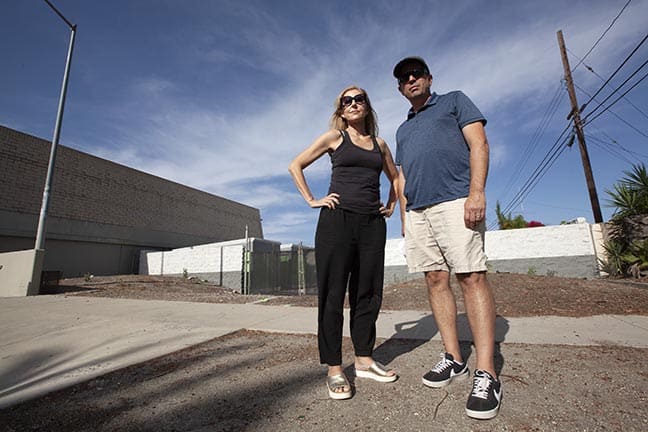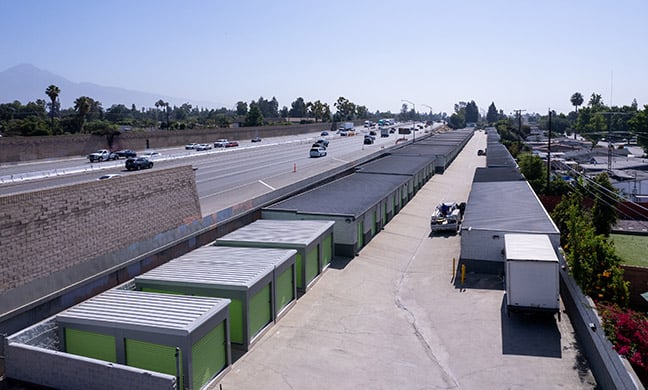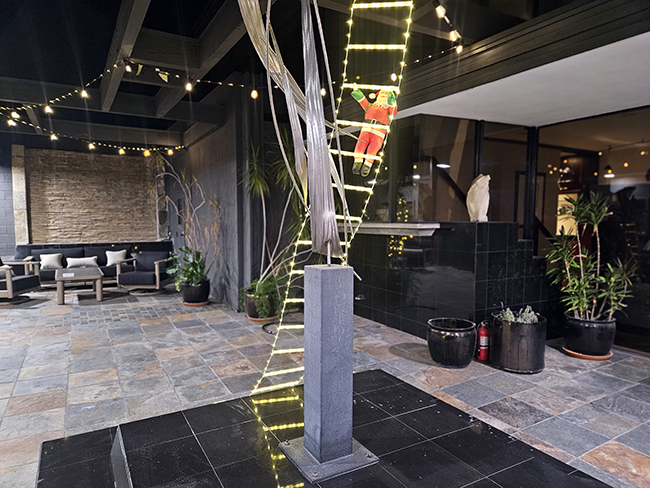Gap in sound wall called an equity issue

Wendy and Joe Ramallo are advocating local transportation agencies to close a roughly quarter mile gap in the sound wall along the south side of Interstate 10 in Claremont. A project to add toll lanes and extensively rework the 10 will also include sound wall construction, however the Ramallos would like to see the wall in Claremont built before that project begins. COURIER photo/Steven Felschundneff
by Steven Felschundneff | steven@claremont-courier.com
For decades, there has been a roughly quarter-mile gap in the protective sound barrier along the eastbound side of Interstate 10 between College and Mills avenues. This span of missing wall allows traffic noise, and small particulate pollution, to pour over the homes situated on Bryn Mawr Road, S. College Avenue, Brown Drive and American Avenue.
This is the only area along Claremont’s two freeways that lacks a sound barrier and those affected say now is the time to fix this inequity.
“Bottom line, the sound wall gap is an environmental and health risk that the families along Bryn Mawr and adjacent streets to the south of ours have had to bear and should be fixed,” Bryn Mawr resident Wendy Ramallo said recently.
Standing at the point where the freeway bisects College, it’s striking how the sound wall abruptly ends with nothing but a narrow self storage establishment between freeway traffic and the homes on Bryn Mawr. The homes on the north side of that street seem particularly vulnerable, with big rig trucks passing just a few dozen feet from their back yards.
Now may be the perfect time to close the gap, due to a regional effort to extend toll lanes along Interstate 10, including miles of new sound walls.
Significant construction is already underway, with the San Bernardino County Transportation Authority adding two express toll lanes and expanding the width of the 10 Freeway from Interstate 15 to the Los Angeles County border. However, that project is in a completely different jurisdiction and ends at precisely the spot where the section of the missing sound wall in Claremont begins.
Meanwhile, a similar project is taking shape in Los Angeles County to extend the toll lanes from the county border to the 605 Freeway in Baldwin Park. And, as it turns out, last Friday was the deadline to register comments with the California Department of Transportation regarding the project, including the request for sound barriers.

Residents on Bryn Mawr Road in Claremont want local transportation authorities to build a sound barrier on the south side of Interstate 10 adjacent to their neighborhood. The wall could be included in a proposed reconfiguration of the 10, however the people who live there would like to see the barrier built before construction begins. COURIER photo/Matt Weinberger
In a letter dated June 9 from Claremont Community Development Director Brad Johnson to Ron Kosinski of Caltrans, Johnson outlines the city’s concerns about the Interstate 10 express lane extension, including installation of a sound wall from College to Mills.
“The current gap in the sound wall infrastructure creates quality of life issues affecting the residential properties directly exposed to the freeway noise and pollution without mitigation. This situation also raises concerns with Noise and Air Quality/Greenhouse Gas Emission issues as well as Community Impacts and quality of life issues for residential neighborhoods to the south of the gap,” according to the letter.
“Moving forward, it is imperative that this gap is effectively addressed and that a sound wall be constructed to close the current gap with the proposed project to address the environmental concerns,” according to Johnson.
He referenced a letter sent last August to Los Angeles County Metropolitan Transportation Authority from then-Mayor Jennifer Stark requesting Metro’s support to complete the sound wall. As it turns out, Metro and Caltrans have dueling responsibilities in the construction of sound barriers.
“With the passage of SB45, the California Street and Highway Code was amended to transfer the programming and funding responsibilities of the Post 1989 Soundwall Retrofit Program to regional transportation planning agencies. In Los Angeles County, Metro assumed this responsibility,” Assistant City Manager Jamie Earl wrote in an email.
However, the sound wall eligibility determination, as well as design and construction responsibilities for the program, remains with Caltrans, according to Earl.
“With the I-10 express lanes project, Caltrans is now responsible for the environmental assessments of the segment that will be impacted by the construction of the project. Since the proposed project includes the sound wall gap section, comments on the gap were submitted to Caltrans in response to Caltrans Express Lane Extension [notice of preparation],” Earl said.
For Wendy Ramallo and her husband Joe, it’s a matter of equity and not simply limited to the sound wall itself, but manifests in a number of issues that make residents in south Claremont feel ignored.
“We bear the impacts of increased crime from the hotels that were allowed to be built that generate tax revenue for the rest of Claremont as well. This is about health and fundamental fairness for the residents of south Claremont,” Wendy Ramallo said.
The Ramallos moved to Bryn Mawr a year ago, and since then have noticed what they say is a marked difference between the amenities in their neighborhood versus those north of the 10. Wendy Ramallo cited the stretch of Mills Avenue that runs through their neighborhood as an example, saying it lacks quality landscaping and basic maintenance typical of other city streets. She also wonders why the “Welcome to Claremont” sign is at Moreno Street where one enters the Russian Village and not down at American where Claremont actually begins.
The Ramallos are not content to wait for Metro and Caltrans to complete the toll lane project on the 10 Freeway — they want the sound wall built now, to resolve the equity issue, and to protect their neighborhood from the disruption caused by the construction.
“Before you expand anything out, protect us, close the sound wall gap. It should be first not last,” Wendy Ramallo said. “You’ve already done the damage. You’ve already created a nice little nook so that all of the crud can come our way, and now you are talking about expanding further and you will get [the wall] in the process for consideration.”
There remains a possibility that the wall will be built prior to the express lane extension project because Metro has money for noise barriers. Councilmember Sal Medina told the Ramallos that Metro inherited a significant number of sound wall projects when they took that authority from Caltrans.
On May 26, the Metro Board of Directors approved an $8.8 billion budget for fiscal year 2022 and 2023, including $20 million for sound wall construction, “to help reduce noise in impacted and often disadvantaged communities.”
“I actually did not know this gap existed until we bought here. But it’s obvious when there is a wall on the north side of the freeway and there is a commercial property there and storage facility, just like there is on the south. And they have a wall and we don’t. There is a huge disparity and an issue of equity that needs to be addressed and remedied,” Joe Ramallo said.










0 Comments